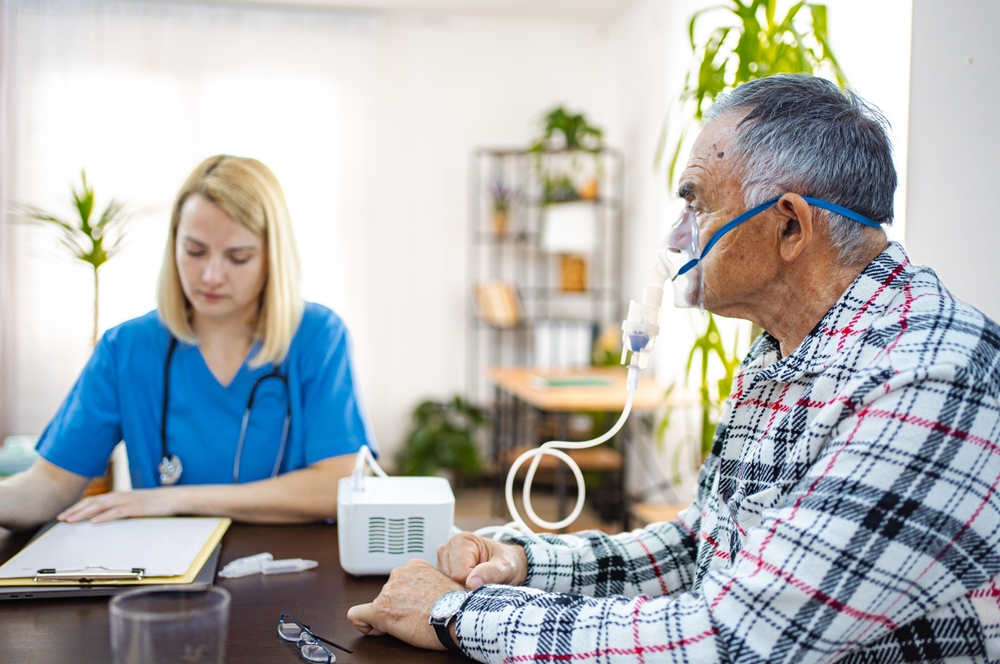As chronic respiratory conditions become increasingly common among aging adults and medically complex individuals, the need for thoughtful, specialized home care has never been greater. Millions of Americans live with respiratory illnesses such as COPD, asthma, and chronic bronchitis—conditions that require ongoing management and support. For many, home is the best place to receive care that promotes comfort, safety, and independence.
At Americare, we understand how challenging it can be to manage breathing problems at home. That’s why we’re committed to providing compassionate, skilled in-home support tailored to the unique needs of respiratory patients. In this guide, we’ll share key strategies to create a safe, healthy, and empowering environment for those living with chronic respiratory diseases.
Understanding Respiratory Challenges at Home
Common Conditions
Chronic respiratory illnesses often develop gradually and can significantly impact daily life. Common conditions we support through in-home care include:
- Chronic Obstructive Pulmonary Disease (COPD)
- Asthma
- Chronic Bronchitis
- Pulmonary Fibrosis
Each of these conditions affects the lungs’ ability to take in oxygen and expel carbon dioxide, making breathing more difficult.
Common Symptoms
People living with respiratory challenges often experience:
- Shortness of breath, especially during physical activity
- Chronic cough and wheezing
- Fatigue or decreased stamina
- Frequent respiratory infections
- Difficulty sleeping or disrupted rest due to breathing issues
These symptoms can intensify without proper management, which is why tailored respiratory care at home is essential.
Essential Home Modifications
Allergen and Air Quality Control
Improving indoor air quality is one of the most impactful ways to support respiratory health. Simple changes can make a big difference:
- Use HEPA air purifiers in main living areas.
- Maintain proper ventilation to reduce moisture and prevent mold growth.
- Eliminate dust collectors, such as heavy curtains, rugs, and stuffed furniture.
- Enforce a no-smoking policy in and around the home.
Reducing allergens and airborne irritants supports clearer breathing and fewer flare-ups.
Emergency Preparedness and Accessibility
Being ready for a respiratory emergency is crucial. Here are some ways you can ensure home safety for COPD:
- Install medical alert systems or personal emergency response devices.
- Keep rescue inhalers, medications, and oxygen supplies easily accessible.
- Post emergency contacts and medication lists in visible areas.
- Ensure all rooms are easy to navigate with minimal tripping hazards.
Proactive planning can prevent small issues from becoming life-threatening situations.
Daily Care Strategies for Caregivers
Medication and Oxygen Therapy Management
Managing medication regimens is vital for home care for respiratory patients.
- Ensure medications are taken exactly as prescribed.
- Monitor for side effects or changes in breathing patterns.
- Use a pulse oximeter to regularly check oxygen saturation.
- Safely manage oxygen therapy at home, ensuring tanks or concentrators are functioning and placed away from heat sources.
Using Nebulizers, Inhalers, and Humidifiers
Proper equipment use can drastically improve symptom control.
- Clean devices daily to avoid bacterial build-up.
- Teach correct inhaler and nebulizer techniques.
- Use humidifiers with distilled water to maintain optimal indoor humidity.
Education and routine play a big role in effective respiratory therapy for seniors.
Monitoring and Logging Symptoms
Keep a daily symptom log that includes:
- Breathing difficulties
- Oxygen levels
- Medication use
- Any new or worsening symptoms
Early detection of changes can prevent hospitalizations and guide care decisions.
Role of Professional In-Home Care
Benefits of Skilled Care for Respiratory Patients
Professional caregivers can help manage complex routines and monitor changes in health. Services may include:
- Assistance with hygiene and mobility
- Medication administration
- Support during breathing treatments
- Coordination with primary care or pulmonary specialists
Tailored care plans ensure that the patient’s needs are consistently met.
How Americare Supports Respiratory Needs at Home
Americare offers trained home health aides who specialize in respiratory therapy for seniors and adults. We support everything from health monitoring to pulmonary rehabilitation, ensuring continuity of care and peace of mind for families. Whether managing advanced COPD or caring for a child with cystic fibrosis, our team is here with expertise and empathy.
Nutrition, Exercise, and Lifestyle Adjustments
Pulmonary Rehab-Approved Exercises
Movement improves lung capacity and overall health. With a doctor’s guidance, patients can try:
- Light walking
- Chair yoga or stretching
- Breathing exercises like diaphragmatic breathing
Always pace activities and monitor oxygen levels before, during, and after.
Diet and Hydration Tips for Respiratory Health

Nutrition is often overlooked but plays a major role in managing respiratory disease. Eating well supports lung health. A balanced diet with anti-inflammatory foods like fruits, vegetables, whole grains, and omega-3s, as well as lean proteins and healthy fats, provides energy and nutrients to help fight infections.
It’s important to note that breathing hard burns extra calories, so people with COPD may need more calories to maintain weight. Offer smaller, more frequent meals if eating makes them breathless. Include nutritious, high-calorie snacks (like nuts, avocado, or yogurt) if weight gain is needed.
Staying hydrated is also key. Water and other fluids help thin mucus, making it easier to cough up. Encourage sipping water or juice throughout the day. Soups and broths can be soothing and hydrating, especially warm drinks like herbal tea. Avoid gas-forming foods and limit salt. Good nutrition and plenty of fluids will help your loved one feel stronger.
Encouraging Safe Physical Activity
Simple strategies include:
- Practicing pursed-lip breathing during moments of exertion
- Avoiding extreme temperatures during exercise
- Scheduling physical activities after taking medications, when breathing is easier
These small changes make a significant impact on daily comfort and function.
Emotional Support
Living with a chronic respiratory illness can be stressful for everyone. Be a patient listener — talk through any worries your loved one has and offer reassurance. Encourage them to do what they can on their own; maintaining some independence can boost confidence. Celebrate small victories, like taking a longer walk or mastering a breathing exercise. Quality of life is about more than medical care – staying active in enjoyable activities and holding a positive attitude can really help.
Caregiver Wellbeing
Caring for someone with a chronic respiratory illness can be deeply rewarding, but also physically and emotionally taxing. It’s important to recognize when the level of care required exceeds what a family member or untrained caregiver can safely provide. Bringing in professional support isn’t a sign of failure — it’s a proactive step toward better health and peace of mind.
Here are signs it may be time to involve a nurse or respiratory therapist:
- Increased frequency or severity of breathing difficulties, especially at rest or during mild activity
- Confusion, dizziness, or blue lips/fingertips, which can indicate low oxygen levels
- Recurring respiratory infections that require antibiotics or ER visits
- Difficulty managing medications, oxygen equipment, or breathing treatments at home
- Worsening fatigue or mobility issues, limiting the patient’s ability to care for themselves
- Emotional burnout or health issues in the primary caregiver
A skilled nurse or respiratory therapist can assess symptoms, adjust treatment routines, and provide advanced care that helps prevent emergencies. Their presence can also give caregivers time to rest, recharge, and focus on their own well-being — ensuring that both patient and family are supported.
Americare’s Personalized Home Care Plans
Every patient’s situation is unique. That’s why we develop custom care plans to address both medical needs and lifestyle goals. Learn more about our services and how to get home health care services from Americare tailored to you or your loved one’s respiratory condition.
How Americare Can Help
Managing a respiratory condition at home can be overwhelming — but you don’t have to do it alone. With the right strategies and professional support, individuals with chronic breathing issues can live safely and comfortably at home. From modifying your environment to building a personalized care team, proactive home respiratory care empowers families and patients alike.

